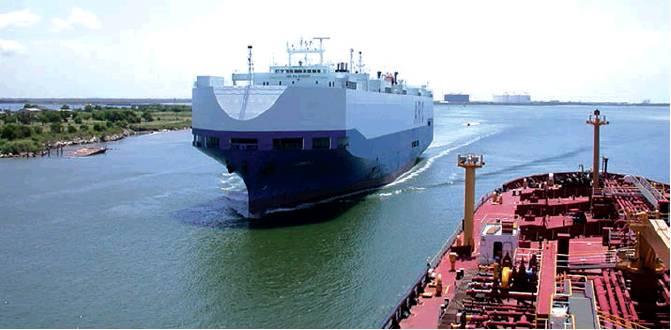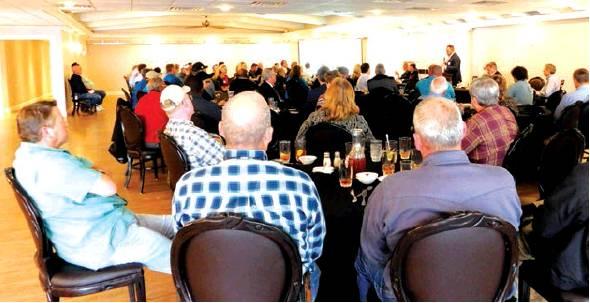Speaking at a Golden Triangle Business Roundtable (GTBR) meeting on March 19, Sabine Neches Navigation District (SNND) Assistant Manager Matthew Kaufman discussed the importance of the Sabine-Neches Waterway and how the ship channel improvement project is already bringing economic benefits to Southeast Texas that will ultimately extend beyond the area and across the nation.
United States Congressman Randy Weber serves the 14th District of Texas and was at the meeting to talk about the Sabine-Neches Waterway deepening project. Weber said he has worked diligently on legislation to help bring the project to fruition.
“This is a great area of Southeast Texas… You all know all the development plans going on there, all the work being done there, all the progress we’ve been making there,” Weber said of the waterway. “I’ve been representing this great district for 6 years, believe it or not, and there’s a lot of work we’ve done on the House Transportation and Infrastructure Committee to help you get that transportation infrastructure bill out. We did a lot of work on infrastructure – a lot of work.”
All that work has paid off, said Weber, and the successful completion of the project will continue to boost the Southeast Texas economy and the national economy in perpetuity.
Golden Triangle Business Round-table Executive Director Dennis Isaacs thanked Weber for his support and agreed that the project would have widespread benefits.
“You know and everyone knows the significance of (the Sabine Neches Navigation District deepening) project in terms of our local economy, our state economy, our international economy, the Department of Defense… Thank you, sir, for your representation.”
Kaufman of the SNND provided a brief history of the waterway and described the navigation district’s role in managing the Sabine-Neches Waterway.
“The Navigation District was established in 1909 as the local non-Federal Sponsor of the Sabine-Neches Waterway,” said Kaufman. “The waterway is the third largest waterway in the nation in tonnage, importing and exporting over 178 million tons of cargo in 2018, or 9 percent of the U.S. total vessel tonnage. There’s more than 50 U.S. Coast Guard regulated waterfront facilities on the waterway that serve our local industry, as well as the Ports of Beaumont, Port Arthur and Sabine Pass.
“As local non-Federal partner, the Navigation District is responsible for cost-sharing federal projects on the waterway with the (Army) Corps (of Engineers), as well as managing the dredged material placement areas and the Taylor’s Bayou navigation locks and floodgates, which reduce the (saltwater intrusion) and protects over 59,000 acres of freshwater marsh.
“We also fund the Jefferson County Sheriff ’s Marine Division via a levy that was agreed upon and placed on vessels serving local industry… It’s part of the industry partnership here.”
Kaufman said even with all the industry currently utilizing property along the waterway, there is still “room to grow,” unlike Houston’s channel.
“They’re landlocked,” Kaufman said of Houston. “We don’t have that issue. We have over 11,000 acres of developable property on the waterway because it’s so long. It’s actually 57 miles long out to the outer marker to get to the Gulf Coast… We’ve got over 417 million cubic yards of capacity in nearly 12,000 acres of placement areas. So, to kind of put that in perspective, the deepening project with the construction and 50 years of maintenance, it’s going to take about 90 million cubic yards of capacity, so we have plenty of room for that project and future growth.”
Energy and trade
“The nation’s energy gateway, the waterway is home to the third largest refining complex in the nation,” described Kaufman. “Three of the Top 10 refineries in the nation are on this waterway, with Motiva at 1, ExxonMobil No. 8, Valero at No. 9. We also have Total, which is ranked 33. We’ll actually be home to the largest refining complex in the United States whenever (ExxonMobil) Beaumont is done with their expansion project. And there are still more and more energy projects coming to the area.”
Refineries along the ship channel also produce 60 percent of the nation’s commercial jet fuel and the majority of U.S. military jet fuel and the channel is responsible for over 85 percent of the nation’s LNG exports, according to SNND.
“In 2016, $11.6 billion (cargo) was exported out of this waterway. In 2017, that number nearly doubled to $20.5 billion worth of exports. In 2018, another 50 percent increase to $30.2 billion worth of exports, and that’s hugely driven by the fact that the LNG facilities came online,” Kaufman shared. “Then you have the ban on crude oil lifted by President (Barack) Obama just before he left office, and it spurred that industry to grow, so we’re seeing that growth on a daily basis on the waterway.”
That, Kaufman explained, translates to a better national economy.
“We actually have a positive trade balance on this waterway,” he said. “We’re exporting more that we’re importing by $15.8 billion. Those projections to 2026, we’re looking at exporting a positive trade balance of $53.2 billion with a total export of $73.3 billion. We are going to impact that trade balance in a positive way.
“There are only four ports in the U.S. that actually have a positive trade balance… All other ports are a negative impact to the nation’s trade deficit, which is a huge topic with the current administration.
“The energy ports are the ports that are going to help us in the trade balance.”
Strategic importance to defense
The waterway is home to two Department of Defense designated military outload ports, the Port of Beaumont and the Port of Port Arthur.
“The Port of Beaumont is actually the largest commercial military outload port in the nation, and it’s home to the 842nd Transportation Battalion headquarters,” said Kaufman. Direct rail to Fort Hood and Fort Polk allows military cargo to be transferred to and from the Port of Beaumont and the Port of Port Arthur to support U.S. efforts abroad, he described, and the waterway provides access to 57 percent of the nation’s strategic petroleum reserves in Louisiana and Texas.
“We also have the Ready Reserve fleet, which in the past few years invested $32 million to upgrade their infrastructure. That will allow them to accommodate up to 11 of the largest-class Naval contract vessels.”
The Sabine-Neches Waterway
Channel Improvement Project
The Sabine-Neches Waterway was last improved in 1962, “taking advantage of the improvements to the Panama Canal,” said Kaufman. The depth was increased to 40 feet. In 2003, the Navigation District funded the Corps of Engineers to begin a feasibility study for a channel improvement project to deepen the waterway to 48 feet.The project was authorized by Congress and signed into law in 2014, but it was a priority long before the 2003 feasibility study. Kaufman said that recent improvements to the Panama Canal have made the expansion even more critical in regard to economic vitality.
“With the completion of the Panama Canal expansion in 2016, the Sabine-Neches Waterway had the need for a deeper channel to remain competitive for the U.S.,Texas and ensure the future growth of Southeast Texas,” he explained. “It’s been a very long, arduous process to get to the point where we’re at now.”
Kaufman credited Congressman Weber and representatives who supported the deepening project for funding provided in 2017 and 2018, and said progress is being made.
“In 2018, this past November, Work Plan 19 was announced to construct the first phase of the project,” said Kaufman.“The phase after that will be to actually start deepening the channel.”
He estimated the project would “ideally” take 7-10 years, and explained that it is dependent on annual funding from the Army Corps of Engineers. However, benefits will begin to manifest much sooner.
“We’re going 8 feet deeper, and we’re actually going to cut half-depth all the way to the Port of Beaumont,” Kaufman said. “So essentially, let’s say it’s an 8-year project to get it done; four years after construction in Year 5, there will be a benefit of 4 additional feet that will increase capacity and increase resiliency.”
The increased depth will also provide defense against shoaling that can occur during severe weather events, like Hurricane Harvey.
“We saw shoaling as shallow as 26 feet at the Port of Beaumont (due to the storm),” he said. “It kept military transport vessels from getting out.”
Unprecedented growth
The deepening of the ship channel will significantly increase its export capacity, said Kaufman, allowing even more cargo to be shipped out than the 178 million tons in 2018 within the next several years.
“The 2026 projections for this waterway are 210 million-plus tons,” he described. “So, you’re talking about a large growth over the next coming years, and it’s all largely due to the LNG exports and the crude exports – a massive, massive impact.”
The impacts of the improvement project will resonate, creating job growth that is projected to extend well beyond Southeast Texas’ borders.
“Benefits to the nation, you’re talking about 530,000 permanent jobs, and that’s direct, indirect, induced all over the nation,” said Kaufman. “So, you’re not just impacting jobs here, you’re impacting jobs all over the nation through the life of that project, not only through the construction jobs – you’ll see a huge boom in that – but permanent jobs that will continue to live on after the construction.”
And while 8 feet may not sound like much of a deepening, Kaufman explained, “Every foot matters.”
“Today they are able to put about 500,000 barrels on a typical vessel. After construction, they are going to be able to put 750,000-plus barrels on that ship, so it’s over a 50 percent capacity increase on one vessel,” he illustrated. “So, post-construction, after it’s built, it’s going to take two ships to move the amount of crude it’s taking three ships to move now.That’s a huge, huge gain in efficiency.”
Kaufman said industry is responding rapidly since the ship channel improvement was made a federal project in November 2018, evident from recent announcements of area construction and expansion projects.
“In December 2018, you had Motiva Enterprises propose (investing $6.6) billion in the petrochemical complex in Port Arthur. Then in January, you had American Ethane breaking ground on a $1.5 billion ethane export project. You had Chevron Phillips propose a $5 billion ethylene expansion project in Orange... ExxonMobil made an FID (final investment decision) on their refinery expansion project in Beaumont,” Kaufman detailed. “You had those three announcements in January… February, Golden Pass made announcements on $10 billion worth of projects on their LNG export facility at Sabine Pass. So, there are a lot of projects coming. They know this waterway’s going to be deepened and they know the benefits of that.”
For more information about the Sabine Neches Navigation District, visit www.navigationdistrict.org.




